Sanjana
It is a small or medium sized tree occurring near the houses, gardens and
roadsides. Leaves are usually 3-pinnate, and leaflets opposite, elliptic, ovate
or obovate. Flowers are white and scented. Fruit is a pendulous capsule,
triquetrous with 9 ribs. Seeds are trigonous and winged. Flowering and
fruiting throughout the year.
Part used: Whole plant
Usage : Effective in ascites, rheumatism and circulatory stimulant, liver
disorder, and also cardiac stimulant. Leaves, flowers and unripe pods are
eaten as vegetables. A paste of leaves heals wounds. Leaves are antinflammatory, anodyne and anthelmintic. Flowers are used as tonic and diuretic. Seed oil is applied externally in rheumatism and gout. A decoction of root is used as a gargle. An infusion of root is used to treat asthma, gout, rheumatism and swellings. The root and root bark paste is applied locally to cure inflammatory swellings. The fresh roots are used as stimulant to treat epilepsy, paralytic affections and as a cardiac and circulatory tonic.
Agrotechniques: It can be easily propagated through seeds or stem cuttings, in rainy season. Fortnightly irrigation and weeding essential in the first year. Fruits yield 10-2S kg! plant.

